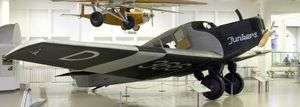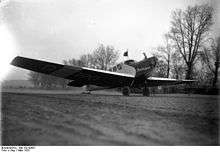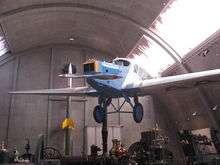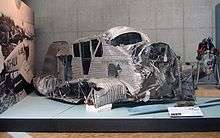Junkers F.13
| F.13 | |
|---|---|
 | |
| Junkers F.13 in the Deutsches Museum | |
| Role | small passenger transport |
| Manufacturer | Junkers |
| Designer | Otto Reuter |
| First flight | June 25, 1919[1] |
| Introduction | 1920 |
| Retired | late 1930s |
| Primary users | Junkers Luftverkehr DLH, LAB, LOT, ÖLAG |
| Produced | 1919–1932 |
| Number built | 322 |
|
| |
The Junkers F.13 (also known as the F 13) was the world's first all-metal transport aircraft, developed in Germany at the end of World War I. It was an advanced cantilever-wing monoplane, with enclosed accommodation for four passengers. Over 300 were sold. It was in production for thirteen years and in commercial service for almost twenty.
Design and development
The F.13[2] was a very advanced aircraft when built, an aerodynamically clean all-metal low-wing cantilever (without external bracing) monoplane. Even later in the 1920s, it and other Junkers types were unusual as unbraced monoplanes in a biplane age, with only Fokker's designs of comparable modernity. It was the world's first all-metal passenger aircraft and Junkers' first commercial aircraft.
The designation letter F stood for Flugzeug, aircraft; it was the first Junkers aeroplane to use this system. Earlier Junkers notation labelled it J 13. Russian-built aircraft used the designation Ju 13.
Like all Junkers duralumin-structured designs, from the 1918 J 7 to the 1932 Ju 46, (some 35 models), it used an aluminium alloy (duralumin) structure entirely covered with Junkers' characteristic corrugated and stressed duralumin skin. Internally, the wing was built up on nine circular cross-section duralumin spars with transverse bracing. All control surfaces were horn balanced.
Behind the single engine was a semi-enclosed cockpit for the crew, roofed but without side glazing. There was an enclosed and heated cabin for four passengers with windows and doors in the fuselage sides. Passenger seats were fitted with seat belts, unusual for the time. The F.13 used a fixed conventional split landing gear with a rear skid, though some variants landed on floats or on skis.
The F 13 first flew on 25 June 1919,[3] powered by a 127 kW (170 hp) Mercedes D IIIa inline upright water-cooled engine. The first production machines had a wing of greater span and area and had the more powerful 140 kW (185 hp) BMW IIIa upright inline water-cooled motor.
Many variants[4] were built using Mercedes, BMW, and Junkers liquid-cooled inline engines, and Armstrong Siddeley Puma, Gnome-Rhône Jupiter and Pratt & Whitney Hornet radial engines. The variants were mostly distinguished by a two letter code, the first letter signifying the airframe and the second the engine. Junkers L5-engined variants all had the second letter -e, so type -fe was the long fuselage -f airframe with a L5 engine.
Operational history

Any manufacturer of civil aircraft immediately after World War I was faced with competition from the very large numbers of surplus warplanes that might be cheaply converted – for example, the DH.9C. German manufacturers had further problems with the restrictions imposed by the Inter-Allied Aeronautical Commission of Control, which banned the production of warplanes and of any aircraft in the period of 1921–2. Junkers[5] picked up orders abroad in 1919 in Austria, Poland and the USA and, in the following years with SCADTA (Colombia) and the United States Post Office Department. John Larsen Aircraft in the USA purchased a production licence, their machines being designated JL-6. In 1922 there were sales in England, France Italy and Japan.
In Bolivia, LAB's first airplane was a Junkers F-13; first flight took off from Cochabamba on September 23, 1925.
Junkers set up its own airline – Junkers Luftverkehr AG in 1921 – to encourage the acquisition of the F.13 by German airlines which was flying 60 of them by 1923. They also established a branch of this airline in Iran. Other marketing techniques were used, providing F.13s on cheap leases and free loans, with such effect that some 16 operators across Europe were flying them. When Junkers Luftverkehr merged into Luft Hansa in 1926, 9.5 million miles had been flown by them. Luft Hansa itself bought 55 aircraft and in 1928 were using them on 43 domestic routes. Even in 1937, their F.13s were flying over 50 flights per week on four routes. They were finally withdrawn in 1938.
Most of the F.13s produced before completion of the marque in 1932 were built at Junkers German base at Dessau. During the difficult 1921–3 period production was transferred to Junkers plants at Danzig and Reval. In 1922–3, Hugo Junkers signed a contract with the Soviet Union to produce the aircraft in a Soviet factory at Fili near Moscow which became known as "Plant no. 22". Some of these aircraft served Soviet airlines and some the Red Army.
There were some other military users. The Colombian Air Force used the F.13 (and the related W.33, W.34 and K.43) as bombers in the Colombia–Peru War in 1932–3. The Republic of China flew F.13s converted into scout bombers until the January 28 Incident in 1932, when they were destroyed by the Japanese along with the Shanghai Aircraft Factory. The Turkish Flying Forces flew a few.
A feature that made the F.13 popular internationally was the ease with which its landing gear could be converted to floats. During the formative years of commercial aviation, bodies of water such as rivers, lakes, seas and oceans were more abundant than landing strips and civil airports in many parts of the world, so seaplanes were commonplace and even, in some places, more useful than regular aircraft. Aside from the obvious addition of floats, little modification was needed for this conversion; however, the different configuration could cause issues with directional control, and so some models had their rudder extended to compensate for this.
From their introduction in 1919, commercial F.13s were in service for more than thirty years; the last commercial F.13 was retired in Brazil in 1951.
A German-Swiss project to build a reconstruction of the F.13 was launched in 2009; the aircraft first lifted off in September 2016. The reconstruction is equipped with radio and a transponder, and uses a 1930s Pratt & Whitney R-985 Wasp Junior motor, but is otherwise as close as possible to the original. Additional reconstructions are to be sold for $2.5 million apiece.[6]
Variants
- F.13
- first prototype, smaller wings (span 14.47 m/47 ft 5.75 in, area 38.9 m² /419 ft²) and less powerful engine 127 kW (170 hp) Mercedes D IIIa inline) than production models.
- F.13a
- first production aircraft with 140 kW (185 hp) BMW IIIa motor.
- F.13ba, ca, da, fa
- all with the 149 kW (200 hp) Junkers L2 upright inline water-cooled engine and a series of structural modifications. The fa variant was about 1 m (3 ft) longer.
- F.13be, ce, de, fe
- as the above but all with 230 kW (310 hp) Junkers L5 upright inline water-cooled engines.
- F.13dle, fle, ge, he, ke
- variants with the Junkers L5 above.
- F.13bi, ci, di, fi,
- as ca to fa but all with the 186 kW (250 hp) BMW IV engine.
- F.13co, fo, ko
- with the 230 kW (310 hp) BMW Va engine.
- Junkers-Larsen JL-6
- American version of the F.13 built by Junkers-Larsen. Eight built.
Operators
- Afghan Air Force acquired four aircraft from 1924 through 1928.
- Argentine Air Force - three aircraft
- Austrian Air Force (1927-1938)
- Österreichische Luftverkehrs AG (ÖLAG) started flying with F.13 and operated 24 aircraft
- Lloyd Aéreo Boliviano received the first F.13 as a gift from the German community on the occasion of the centennial of Bolivian independence.
- Bulgarian Air Force
- Bunavad operated two aircraft between 1927 and 1928.
- Danziger Luftpost
- Lloyd Ostflug
- Aeronaut operated F.13 between 1922 and 1927.
- Aero Airways
- Kauhajoki Flying Club
- Finnish Air Force
- Finnish Border Guard
- Junkers Luftverkehr, primary user until merger with Deutscher Aero Lloyd into Deutsche Luft Hansa
- Deutsche Luft Hansa operated about 110 aircraft, a large part taken over from Junkers Luftverkehr
- Aero R.T. operated six aircraft between 1923 and 1927.
- Royal Hungarian Air Force
- Air Iceland operated three aircraft between 1928 and 1931.
- Lithuanian Air Force operated prototype aircraft, that crash-landed in Lithuania after illegally passing its border in 1919.
- Mongolian People's Army Air Force operated three aircraft between 1925 and 1931.
- Aero-Targ leased six aircraft from Danziger Luftpost in 1921.
- Aerolloyd (later renamed Aerolot) operated 16 aircraft between 1922 and 1929.
- LOT Polish Airlines took over 15 remaining aircraft from Aerolot and operated them between 1929 and 1936.
- Serviços Aéreos Portugueses operated one aircraft between 1929 and 1931.
- Aviaarktika operated several aircraft.
- Soviet Air Force
- South African Airways operated four aircraft obtained from Union Airways.
- South African Air Force
- Union Aérea Española UAE
- Fuerzas Aéreas
- Cruz Roja Española
- Ad Astra Aero operated at least four F.13s (registered CH-91/92/93/94) between 1919 and probably 1930.
- Turkish Air Force operated three aircraft between 1925 and 1933.
- Turkish Air Post operated two ex-military aircraft between 1933 and 1938.
- General Command of Mapping (Turkey) operated one ex-air force aircraft (serial no: 882) equipped with aerial photo system from 1933 to 1938.[7]
- Civil register lists five F.13s during the 1930s[8]
Accidents and incidents
- On 1 September 1920, a Junkers-Larsen JL-6(the American version of the Junkers F.13 that was assembled in the United States) caught fire and crashed in Morristown, NJ. Max Miller, the United States Air Mail Service's first pilot was at the controls and, along with his mechanic/crewman, Gustav Reierson, perished. They managed to eject all nine mail bags before the plane hit the ground.
- On 8 June 1924, a SCADTA F.13, registration A13, stalled and crashed into a tree on takeoff from Barranquilla, Colombia, killing all five on board.
- On 22 March 1925, a Zakavia F.13, registration R-RECA, crashed on takeoff from Tiflis, Georgia, killing all five on board.
- On 24 July 1926, a Deutsche Luft Hansa F.13, registration D-272, crashed at Juist, Germany due to weather, killing all four on board.
- On 3 September 1926, a SCADTA F.13, registration A-10, collided with cloud-obscured terrain between Honda and La Victoria, Colombia. The two crew and two passengers were injured, and the aircraft was a total loss.
- On 27 July 1927, a Deutsche Luft Hansa F.13, registration D-206, crashed at Amöneburg, Germany after attempting an emergency landing due to engine failure, killing all five on board.
- On 26 May 1928 at 08:15, a Deutsche Lufthansa Junkers F 13, registration D-583, crashed at Hahnenberg, Radevormwald, Germany due to pilot error, killing three of five on board.
- On 21 July 1930, a Croydon-based Walcot Air Line F.13, registration G-AAZK, crashed at Meopham, near Gravesend, Kent, due to structural failure, killing all six on board including its pilot, the well-known Lt Col George L P Henderson.
- On 2 November 1932 a Deutsche Luft Hansa F.13, registration D-724, crashed at Echterpfuhl, Germany due to wing separation, killing all five on board.
- On 9 October 1935, an Aero/OY F.13, registration OH-ALI, crashed into the Gulf of Finland in fog, killing all six on board.
Survivors

- Aircraft on display
- Reserve collection[10] Musée de l'Air et de l'Espace, Le Bourget, Paris, France[11]
- Deutsches Museum Munich, Germany[12]
- Transport Museum of Budapest, Hungary[13]
- SE-AAC, ex-D-343, Tekniska museet, Stockholm, Sweden[14]

- In storage or under restoration
- Deutsches Technikmuseum Berlin, Germany
Specifications (F.13)

Data from Wagner 1996 p.155 & Turner 1971 p.20
General characteristics
- Crew: two
- Capacity: four passengers or 689 kg (1,519 lb) payload
- Length: 9.59 m (31 ft 6 in)
- F.13fe: 10.50 m (34 ft)
- Wingspan: 14.8 m (48 ft 7 in)
- F.13fe: 17.75 m (58 ft)
- Height: 3.50 m (11 ft 6 in)
- F.13fe: 3.60 m (12 ft)
- Wing area: 34.50 m2 (371.4 sq ft)
- F.13fe: 44 m2 (474 sq ft)
- Empty weight: 951 kg (2,097 lb)
- F.13fe: 1,480 kg (3,263 lb)
- Max takeoff weight: 1,640 kg (3,616 lb)
- F.13fe: 2,318 kg (5,110 lb)
- Powerplant: 1 × Mercedes D.IIIa 6-cyl.water-cooled in-line piston engine, 118 kW (158 hp)
- F.13fe: 1 x 228 kW (306 hp) Junkers L5 6-cyl. water-cooled in-line piston engine
Performance
- Maximum speed: 173 km/h (107 mph; 93 kn)
- F.13fe: 198 km/h (123 mph)
- Cruising speed: 160 km/h (99 mph; 86 kn)
- F.13fe: 170 km/h (106 mph)
- Range: 1,400 km (870 mi; 756 nmi)
- Service ceiling: 5,000 m (16,404 ft)
- F.13fe: 5,090 m (16,699 ft)
- Rate of climb: 2.40 m/s (472 ft/min)
- Power/mass: 0.0712 kW/kg (0.0443 hp/lb)
See also
Related developments
References
Notes
- ↑ Wolfgang Wagner "Hugo Junkers Pionier der Luftfahrt - Seine Flugzeuge" Bernard & Graefe Verlag, Bonn 1996 ISBN 3-7637-6112-8 (in German)
- ↑ Turner & Nowarra 1971, pp. 17–18
- ↑ Swopes, Bryan R. "25 June 1919". This Day in Aviation. Retrieved 26 June 2014.
- ↑ Turner & Nowarra 1971, p. 19
- ↑ Turner & Nowarra 1971, pp. 18–20
- ↑ "Junkers F13 Makes a Triumphant Return to the Skies". Flying Magazine (20 September 2016). Retrieved 25 September 2016.
- ↑ General Command of Mapping in Turkey
- ↑ British Civil Register.
- ↑ http://hugojunkers.pytalhost.com/ju_f13_m9.htm
- ↑ Reserve collection, Museé de L'Air, Le Bourget
- ↑ Museé de L'Air, Le Bourget
- ↑ F 13 at Deutsches Museum, Munich
- ↑ F 13 at the Budapest Aircraft Museum
- ↑ F 13 at the Technical Museum, Stockholm
Bibliography
- Turner, P.St. John; Nowarra, Heinz J. (1971). Junkers: an aircraft album No.3. New York: Airco Publishing Co. Inc. pp. 17–20. ISBN 0-668-02506-9.
Further reading
- Waernberg: Junkers F-13 det forsta trafikflygplanet i Sverige (Karlskrona 1992) OCLC 186409952
- Vagvolgyi: Junkers F-13 : a Junkers repulogepek tortenete 1909-tol 1932-ig"
- Stroud: Wings of Peace: The Junkers F13 (Aeroplane Monthly)
- Pohlmann: Prof. Junkers nannte es "Die Fliege" (ISBN 3-87943-982-6)
- Wagner: Junkers F13 und ihre Vorlaeufer (ISBN 3-88064-015-7)
- Endres: The Junkers F13 in Poland (Air Pictorial)
- Cicalesi, Juan Carlos; Rivas, Santiago (2009). Núñez Padin, Jorge Felix, ed. Junkers F13 / W34 / K43 / Ju52. Serie en Argentina (in Spanish). 3. Bahía Blanca, Argentina: Fuerzas Aeronavales. ISBN 978-987-20557-7-6. Retrieved 2015-08-24.
External links
| Wikimedia Commons has media related to Junkers F 13. |
- Junkers F 13
- Junkers F 13 photos from the Budapest Aviation Museum
- Hugo Junkers Homepage
- The Hugo Junkers site